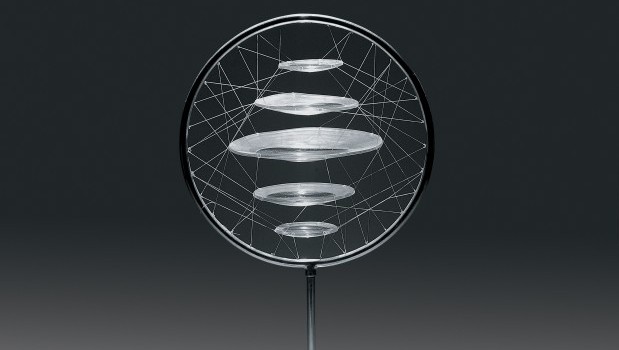
Saloua Raouda Choucair
Waterlens 1969–1971, detail
© Saloua Raouda Choucair Foundation
The four small rooms that hold the Saloua Raouda Choucair retrospective at the Tate Modern truly offer the most surprising and enjoyable experience available in London this summer.
Choucair was born in 1916 and continues to work in her ninety-seventh year, although ill health prevented her from travelling to London for the opening of this landmark show. Choucair—or Raouda, as she was known at the time—studied in Paris after World War II with Fernand Léger, the Cubist legend. Léger had spent the war in exile in the United States.
The return to a broken and defeated France saw a change in Léger’s work, a move away from abstract and architectural pieces that he used to depict social and Left-wing themes to a more figurative style. Photographs from the period show Choucair as a dark-eyed, beautiful woman at ease in his studio, yet when one sees how her own work developed over the next decade, one wonders if she was disappointed by Léger’s late period work. Perhaps she had hoped to be a part of the more challenging art of Léger’s inter-war years. At that time he was a friend of the ultra-Modernist architect Le Corbusier, who made works intended to compete against the futuristic buildings of new cities.
Choucair’s Parisian paintings are delightful, as bright and lovely as any late Cubist paintings. The poster for the Tate’s retrospective is taken from this time: a casual, rather student-y self-portrait of Choucair looking intense. Yet this painting is far from representative of the work in this exhibition: the bulk of the show comes from after her return to Beirut in the 1950s. It is a revelation.
In Lebanon, Choucair developed a new, exclusively abstract body of work. It is unclear whether her decisive turn away from figurative painting was inspired, at least in part, by the traditional Islamic discomfort with representation in art. If so, it is worth noting that no one else in the Middle East was making abstract work at this time: Choucair was a lonely pioneer. Indeed, she did not sell any work at all until she was in her fifties. Two of her series stand out. The first is composed of carved stones that can be stacked in different formations, even moved around at will, inviting the spectator to rework the displays—a revolutionary idea that one would struggle to find in Europe until the 1970s. The second features towering wooden structures, composed from dozens of horizontal shelves holding small, abstract wooden figures. The result is that each tower in some way resembles both a bookcase in a library and, oddly, a page of text inside a book, written in a private, sculptural language. Both these series clearly respond to the art of calligraphy, yet in hitherto unknown and entirely original ways.
By the 1970s, Choucair had extended what might be termed architectural abstraction beyond stone and wood into Perspex and steel, soft nylon and even jets of water. For more than sixty years, she has managed to stay ahead of the international art scene, while remaining entirely unknown within it. This will surely change after a major retrospective at the world’s most-attended art gallery. Credit is due to friends in Beirut who have championed her, to the Tate curators who re-discovered her, and above all to a unique, courageous and—one assumes—determined and driven woman.
“Saloua Raouda Choucair” will be showing at the Tate Modern, London, until October 20.
